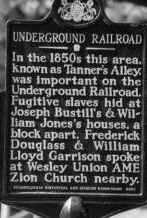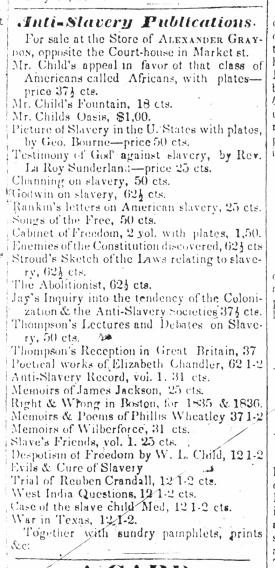
Study Areas:
Underground Railroad
Underground Railroad Chronology
1837: Alexander Graydon's Anti-Slavery Stance
July 1837: The Graydon family of Harrisburg was generally committed to the anti-slavery cause at at time when few white Harrisburg residents shared their beliefs. As a consequence of being at odds with their neighbors over this issue they sometimes found themselves omitted from social functions and suffered public snubs by parts of Harrisburg's social elite. One family member, Alexander Graydon, staunchly refused to be intimidated by the slights and publicly trumpeted his unpopular human rights stance. In 1836 he hosted the town's first anti-slavery lecture in his parlor, inviting a Philadelphia Quaker to address interested residents on the topic. Unfortunately, the meeting was thinly attended.
Undeterred, Graydon began offering anti-slavery publications for sale at his Market Street store, which was located on the south side, in the 200 block of Market Street. He advertised twenty-nine different titles, few if any of which were available from the town's other two booksellers. He placed advertisements in the local Pennsylvania Telegraph, running the ads for several consecutive issues in the summer of 1837 and ran the same ads again in the fall. Facing meager sales of the books and enduring vocal and social opposition to his beliefs from members of his own church, Alexander Graydon moved his family away from Harrisburg within a few months, relocating to Indianapolis where he found more support for his activities.
 Left: Anti-Slavery
Publications.
Left: Anti-Slavery
Publications.
For sale at the store of ALEXANDER GRAYDON, opposite the Court-house in Market
st.
Mr. Child's appeal in favor of that class of Americans called Africans, with
plates--price 37 cts.
Mr. Child's Fountain, 18 cts.
Mr. Child's Oasis, $1.00.
Picture of Slavery in the U.States with plates, by Geo. Bourne--price 50 cts.
Testimony of God against slavery, by Rev. La Roy Sunderland--price 25 cts.
Channing on slavery, 50 cts.
Godwin on slavery, 62 cts.
Rankin's letters on American slavery, 25 cts.
Songs of the Free, 50 cts.
Cabinet of Freedom, 2 vol. with plates, 1,50.
Enemies of the Constitution discovered, 62 cts
Stroud's Sketch of the Laws relating to slavery, 62 cts.
The Abolitionist, 62 cts.
Jay's Inquiry into the tendency of the Colonization & the Anti-Slavery
Societies 37 cts.
Thompson's Lectures and Debates on Slavery, 50 cts.
Thompson's Reception in Great Britain, 37
Poetical works of Elizabeth Chandler, 62 1-2
Anti-Slavery Record, vol. 1. 31 cts.
Memoirs of James Jackson, 25 cts.
Right & Wrong in Boston, for 1835 & 1836.
Memoirs & Poems of Phillis Wheatley 37 1-2
Memoirs of Wilberforce, 31 cts.
Slave's Friends, vol. 1. 25 cts.
Despotism of Freedom by W. L. Child, 12 1-2
Evils & Cure of Slavery
Trial of Reuben Crandall, 12 1-2 cts.
West India Questions, 12 1-2 cts.
Case of the slave child Med, 12 1-2 cts.
War in Texas, 12 1-2.
Together with sundry pamphlets, prints &c.
Source:
Pennsylvania Telegraph (Harrisburg, PA) July 27, 1837.
Now Available
The Year of Jubilee
Vol. 1: Men of God and Vol. 2: Men of Muscle
by George F. Nagle
The Year of Jubilee is the story of Harrisburg'g free African American community, from the era of colonialism and slavery to hard-won freedom.
 Volume One, Men of God, covers the turbulent beginnings of this community,
from Hercules and the first slaves, the growth of slavery in central
Pennsylvania, the Harrisburg area slave plantations, early runaway
slaves, to the birth of a free black community. Men of God is a detailed
history of Harrisburg's first black entrepreneurs, the early black
churches, the first black neighborhoods, and the maturing of the social
institutions that supported this vibrant community.
Volume One, Men of God, covers the turbulent beginnings of this community,
from Hercules and the first slaves, the growth of slavery in central
Pennsylvania, the Harrisburg area slave plantations, early runaway
slaves, to the birth of a free black community. Men of God is a detailed
history of Harrisburg's first black entrepreneurs, the early black
churches, the first black neighborhoods, and the maturing of the social
institutions that supported this vibrant community.
It includes an extensive examination of state and federal laws governing slave ownership and the recovery of runaway slaves, the growth of the colonization movement, anti-colonization efforts, anti-slavery, abolitionism and radical abolitionism. It concludes with the complex relationship between Harrisburg's black and white abolitionists, and details the efforts and activities of each group as they worked separately at first, then learned to cooperate in fighting against slavery.
Non-fiction, history. 607 pages, softcover.
 Volume Two, Men of Muscle takes the story from 1850 and the Fugitive Slave Law of 1850, through the explosive 1850s to the coming of Civil War
to central Pennsylvania. In this volume, Harrisburg's African American
community weathers kidnappings, raids, riots, plots, murders, intimidation,
and the coming of war. Caught between hostile Union soldiers and deadly
Confederate soldiers, they ultimately had to choose between fleeing
or fighting. This is the story of that choice.
Volume Two, Men of Muscle takes the story from 1850 and the Fugitive Slave Law of 1850, through the explosive 1850s to the coming of Civil War
to central Pennsylvania. In this volume, Harrisburg's African American
community weathers kidnappings, raids, riots, plots, murders, intimidation,
and the coming of war. Caught between hostile Union soldiers and deadly
Confederate soldiers, they ultimately had to choose between fleeing
or fighting. This is the story of that choice.
Non-fiction, history. 630 pages, softcover.
Order print copies at Amazon by clicking the book covers, above.

